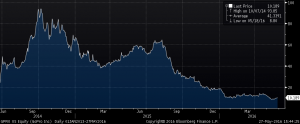The concept of averaging down, or adding more shares to an existing security position when the price falls, is well known to many investors. In fact, some of history’s best investors have added considerable wealth by adding to positions that have declined temporarily. However, investors should not simply increase their holdings in a given security because it has fallen. Doing so blindly can lead to considerable losses and make a bad investment an even worse investment. It is important for investors to know when to exit a position and move on.
It is essential to remember that just because a stock once traded for a particular price does not mean it will return to that level. In the past, we referred to a JP Morgan Asset Management study which found that roughly 40% of all stocks in the Russell 3000 (the 3,000 largest U.S. companies by market capitalization) have suffered a permanent decline of 70% or greater from their peak levels.
By increasing the number of shares we own of a security at progressively lower prices, we lower our overall cost basis in the shares. In theory, this should also make it easier to make a losing investment into a profitable one, as our breakeven price falls as we add shares at a lower cost.
Let’s use an example to demonstrate what could happen. Action-camera maker GoPro went public at $24 per share in June 2014. Assume you bought 100 shares at the IPO price and added 25 shares on each of the 20 times the stock closed at an all-time low. You would now own 600 shares with a cost basis of $16.62 per share (excluding commissions). You would also be down almost 40% (nearly $4,000) on your total investment.
Thinking a share price decline is temporary or that the price will not fall further without understanding what might have caused the price decline is a strategy that can significantly hamper returns. As we stated up front, doubling down on an investment that falls can be a winning strategy. However, it is important to understand the reasons for the decline. An assessment should be made as to whether the decline appears to be temporary due to market-related factors that are not specific to the company or company-specific factors that the investor believes will ultimately reverse. If neither of these situations apply, then exiting the position may be the best way to proceed.
It is important to regularly follow all stocks in a portfolio and understand why they are either outperforming, performing in line with expectations or underperforming. If a stock falls below your initial purchase price, it is particularly important that you understand what may have caused the decline. The original reasons for buying the stock should also be reviewed to make sure they still apply. At BWFA, when we add a new stock to client portfolios, we make sure to have an investment thesis supporting our positive outlook for the company. We regularly revisit this thesis as part of our ongoing review of stocks held in client portfolios. When a stock falls meaningfully, we also want to make sure we understand the reasons behind the decline.


